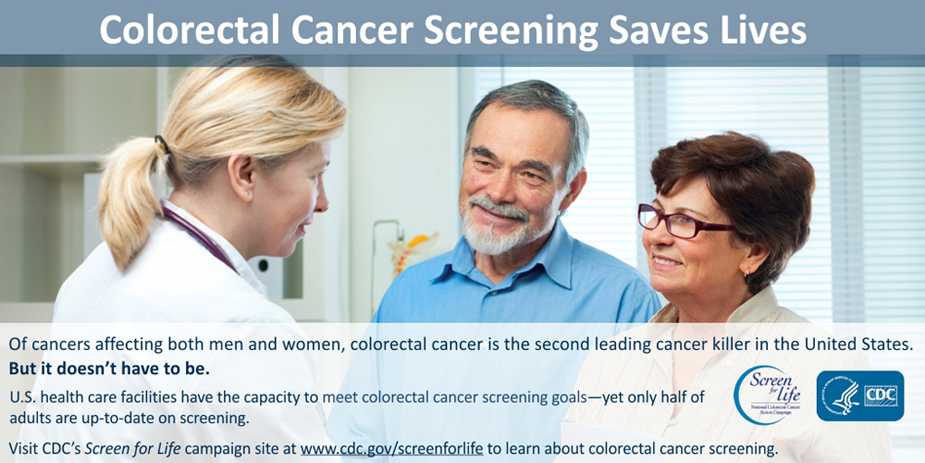U.S. healthcare facilities have capacity to meet colorectal cancer screening goals
Yet only half of adults ages 50-75 are up-to-date on screening
This website is archived for historical purposes and is no longer being maintained or updated.
Press Release
For immediate release: Wednesday, June 22, 2016
Contact: Media Relations
(404) 639-3286

Colorectal Cancer Screening Saves Lives
Of cancers affecting men and women, colorectal cancer is the second leading cancer killer in the United States.
But it doesn’t have to be.
U.S. health care facilities have the capacity to meet colorectal cancer screening goals – yet only half of adults are up-to-date on screening.
Visit CDC’s Screen for Life campaign at www.cdc.gov/screenforlife to learn about colorectal cancer screening.
US government agencies and their colorectal cancer prevention partners have set a goal that at least 80% of adults ages 50-75 will be screened for colorectal cancer. A recently published study conducted by researchers at the Centers for Disease Control and Prevention (CDC) shows that the U.S. healthcare system has the capacity to make this goal a reality.
To determine if the U.S. could expand its screening capacity, CDC researchers used mathematical modeling to estimate the number of colonoscopies or fecal immunochemical tests (FIT) that would be necessary every year to screen for colorectal cancer for 80 percent of adults in the recommended age group. They found that 5.1 million to 13 million colonoscopies would need to be conducted per year, depending on which screening test was first used.
The analysis also used survey data from facilities that perform colonoscopies to determine the number of colonoscopies that are performed in the U.S. every year – and to calculate how many more they could do. This survey showed that 15 million colonoscopies were performed in the U.S. in 2012, and that another 10.5 million colonoscopies could be performed every year.
“Colorectal cancer is the second leading cancer killer for men and women in the U.S., but it doesn’t have to be,” says Djenaba Joseph, MD, MPH, medical director of the colorectal cancer control program at CDC and lead author of the paper. “Screening saves lives. The good news is that our modeling shows that the U.S. healthcare system has the potential to meet our national goal of screening 80 percent of adults ages 50-75. Ask your doctor about screening – there are several options now.”
Of the cancers affecting both men and women, colorectal cancer (cancer of the colon or rectum) is the second leading cancer killer in the U.S. Screening can find precancerous polyps – abnormal growths in the colon or rectum – so they can be removed before turning into cancer. Screening also helps find colorectal cancer at an early stage, when it is easier to treat.
The U.S. Preventive Services Task Force (USPSTF) recently reinforced its recommendations that adults ages 50-75 be screened for colorectal cancer. This recommendation continues to receive USPSTF’s highest rating—an “A” grade, indicating that the evidence is convincing that screening for colorectal cancer has substantial benefits. But only a little more than half of the target population is up-to-date with screening
The new study, “Colorectal Cancer Screening: Estimated Future Colonoscopy Need and Current Volume and Capacity,” is published online in the Journal Cancer.
CDC’s Screen for Life campaign has free resources to promote screening available in English and in Spanish at http://www.cdc.gov/cancer/colorectal/sfl.
- Page last reviewed: January 1, 2016 (archived document)
- Content source:



 ShareCompartir
ShareCompartir